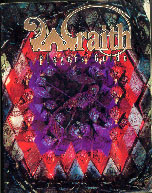
Reviewed by Mike Spera I found the players guide to be immensly helpful, to storytellers as well as players. The book is a must for anyone serious Wraith gamer or storyteller. The artwork is weird, surreal, and goes to show that the Underworld is a strange place. The Ghost Story that opens up the book centers around everyone's favorite dead Bostonian, Erik. The Introduction gives a brief outline of the book, the chapters, each chapter's purpose, and various films and books to act as inspiration. Chapter 1 is simply called "Traits," but don't let the simple title fool you, there's a ton of stuff packed in here. It starts by explaining the Merit/Flaw system, then gives you 14 pages of Merits and Flaws for your character. It then goes on to describe 9 new Shadow Archetypes, as well as unique Harrowings for each type. The Harrowing descriptions are divided into beginning, middle, and end, with outcomes for either a success, failure, or botch. Next comes Psyche Archetypes, which is somewaht disappointing... There are three, and that's it. There are two new backgrounds, Legacy and Old Soul, followed by TONS of Abilities: 15 pages' worth. Well, I'd have to say that I got my money's worth on this chapter alone. But wait, there's more! Chapter 2 gives details on the three factions: Heirarchy, Heretic, and Renegade: the ins and outs, the mentionable positions and people, views on others, and more. Chapter 3 gives an exhausting look at the Dark Kingdoms all around the world, from China to Middle America to Africa to the Caribbean to India to Australia to Ploynesia. Chapter 4 starts with an in-character explanation on the confusing geography of the Shadowlands, the Tempest, and everything in between. Next comes a more detailed explanation of the basic wraith powers: Deathsight, Lifesight, Sharpened Senses, Insubstantiality. After that, information on losing Passions and Fetters, increasing current Passions, getting completely new Passions. Finally, chapter 4 ends with some information on how wraiths can work with computers and the digital web. Chapter 5 explains the 3 lost guilds: the Alchemists that practice Flux, the Solicitors that practice Intimation, and the Mnemoi (ne-MOY), who practice Mnemosynis. Chapter 6 is actually a batch of essays by the game designers themselves on what Wraith: The Oblivion means to them and their thoughts on how ghosts represent certain things in our society: memories of things past, people and ideas that just won't die, and fears that we have. With the exception one or two essays, very little of the material in chapter 6 will have any game effect. Just read it and let it make you think. Finally, the book wraps up with a large cheat sheet of Arcanos. Isntead of looking through the bulky rulebook to find the Arcanos pages, they lay it out all nice and simple. It includes the name, one sentence description of what it does, the rating, Attribute, Difficulty, and cost. Very helpful. All in all, if you want to play Wraith: The
Oblivion seriously, buy two books: the core rulebook and the
Wraith Players Guide. This book has atmosphere, atmosphere, and
atmosphere if nothing else. I give it a solid 5 out of 5 skulls. Reviews on the Wraith Project are the opinions of those reviewers, and are not necessarily those of the Wraith Project themselves. If you disagree with this review, send in another one. If you still feel like strangling the reviewer, see an analyst. |
